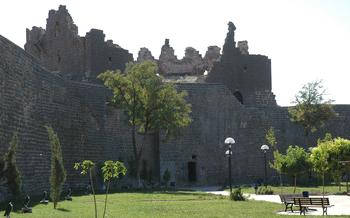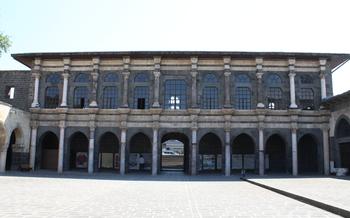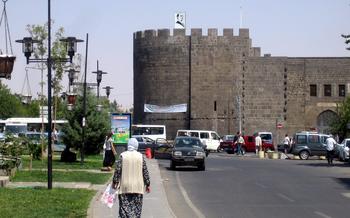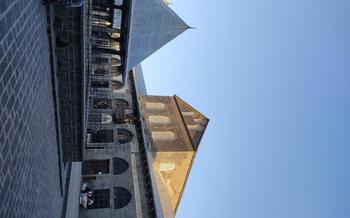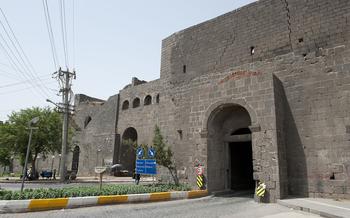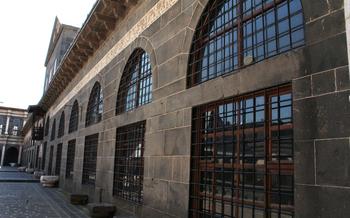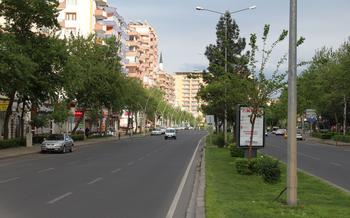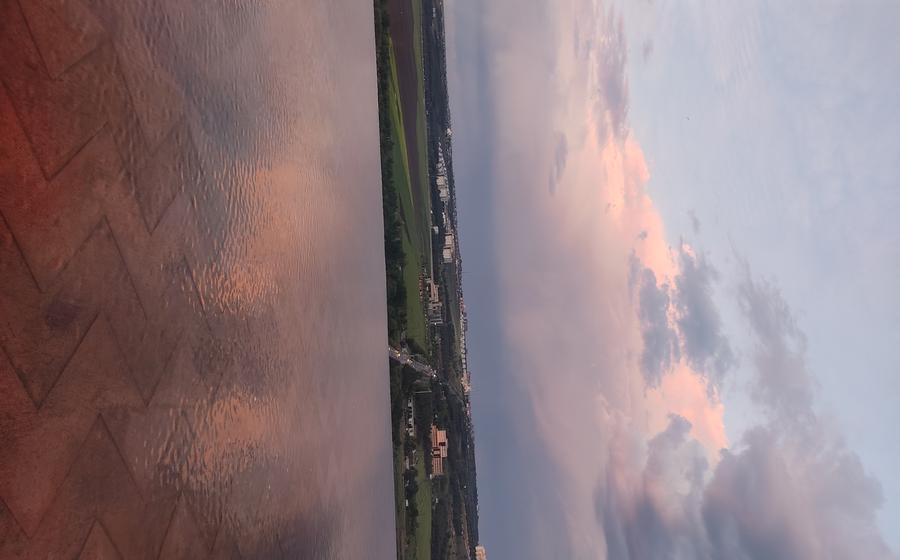
Hevsel Gardens Cultural Landscape
- History of the Hevsel Gardens
- Geography and Location
- Cultural Significance
- Biodiversity and Wildlife:
- Terraces and Agriculture
- Historical Monuments and Ruins
- Walking and Hiking Trails
- Birdwatching and Wildlife Observation
- Cultural Events and Festivals
- Local Cuisine and Dining Options
- Photography Opportunities
- Accessibility and Visitor Information
- Sustainable Tourism Practices
- Insider Tip: Unveiling the Hidden Oasis
History of the Hevsel Gardens
The Hevsel Gardens, a cultural landscape of outstanding universal value, holds a rich history that intertwines with the ancient civilizations that have shaped the region. Its origins can be traced back to the 9th century BC, when the city of Diyarbakır was founded by the Arameans. The gardens served as a vital part of the city's defense system, providing food and water during times of siege. Over the centuries, Hevsel Gardens witnessed the rise and fall of various empires, including the Romans, Byzantines, Arabs, Seljuks, and Ottomans, each leaving their mark on the landscape. The gardens' strategic position near the Tigris River made them a crucial trade and cultural hub, facilitating the exchange of goods and ideas between different civilizations. This rich tapestry of history has bestowed upon Hevsel Gardens a unique character, reflecting the city's multicultural past and serving as a testament to its enduring resilience. In recognition of its exceptional value, Hevsel Gardens was inscribed as a UNESCO World Heritage Site in 2015, further solidifying its status as a global treasure.
Geography and Location
Hevsel Gardens are situated in a captivating geographical setting, nestled beside the majestic Tigris River that meanders through the ancient city of Diyarbakır. This unique location has played a pivotal role in shaping the gardens' significance. The gardens are meticulously laid out, featuring an intricate network of terraces, waterways, and a flourishing diversity of vegetation. The surrounding mountains and the river create a unique microclimate, fostering the growth of a rich and varied ecosystem. The gardens' proximity to Diyarbakır city center makes it easily accessible for visitors, inviting them to explore the cultural and natural treasures that lie within.
Cultural Significance
Hevsel Gardens holds immense cultural significance for the people of Diyarbakır and the surrounding region. Throughout history, it has served as a gathering place for local communities, hosting traditional celebrations, festivals, and ceremonies. These events bring people together to share their culture, music, dance, and cuisine, creating a vibrant and festive atmosphere within the gardens.
The gardens are deeply integrated into local folklore, legends, and stories, passed down from generation to generation. These tales often feature mythical creatures, magical beings, and heroic figures associated with Hevsel Gardens, adding to its mystical allure. The gardens have also inspired local artists, musicians, and writers, who have captured their beauty and significance in their works, ensuring that the cultural legacy of Hevsel Gardens continues to thrive.
Biodiversity and Wildlife:
The Hevsel Gardens are a haven for biodiversity, supporting a diverse range of flora and fauna. The gardens are home to over 200 species of plants, including rare and endangered species such as the Diyarbakır iris and the Kurdish oak. The gardens also provide a habitat for a variety of bird species, including migratory birds such as the European bee-eater and the hoopoe. The presence of these diverse species contributes to the ecological value of the gardens, making them an important conservation area.
The waterways and irrigation system within the gardens create a unique microclimate that supports the growth of a variety of plant species. The gardens are also home to a variety of wildlife, including birds, reptiles, and amphibians. The presence of these species adds to the biodiversity of the gardens and makes them a popular destination for wildlife enthusiasts.
Ongoing efforts are being made to conserve and protect the biodiversity of the Hevsel Gardens. These efforts include the establishment of a nature reserve, the implementation of conservation measures, and the promotion of sustainable tourism. The Hevsel Gardens are a valuable example of the importance of biodiversity conservation and the need to protect our natural heritage.
Terraces and Agriculture
The Hevsel Gardens are characterized by a system of terraces that create a unique agricultural landscape. These terraces were constructed over centuries by local communities to maximize the use of available land and water resources. The terraces follow the natural contours of the land, creating a stepped effect that allows for efficient irrigation and drainage.
Traditional farming techniques are still used in the gardens, including crop rotation and intercropping. Farmers rotate different crops on the terraces to maintain soil fertility and prevent pests and diseases. They also practice intercropping, growing different crops together on the same plot to maximize yield and reduce the risk of crop failure.
The variety of crops grown in Hevsel Gardens reflects the region's rich agricultural heritage. Farmers cultivate a wide range of fruits, vegetables, and grains, including wheat, barley, lentils, chickpeas, tomatoes, cucumbers, melons, and grapes. The gardens are also home to a variety of fruit trees, such as apple, pear, plum, and apricot trees.
In recent years, there has been a growing emphasis on sustainable agriculture in Hevsel Gardens. Farmers are adopting practices that minimize the use of chemical fertilizers and pesticides, and they are working to conserve water and soil resources. These efforts are helping to preserve the unique agricultural heritage of the gardens while ensuring their long-term sustainability.
Historical Monuments and Ruins
Hevsel Gardens is not only a natural wonder but also a treasure trove of historical monuments and ruins that speak to the region's rich past. As you stroll through the gardens, you will encounter ancient city walls, bridges, and religious structures that have stood the test of time. The city walls, with their imposing gates and towers, once served as a protective barrier for Diyarbakır and are a testament to the city's resilience. The bridges, spanning the Tigris River and its tributaries, have facilitated trade and communication for centuries and offer breathtaking views of the surrounding landscape.
Religious structures, such as mosques, churches, and monasteries, add to the cultural and spiritual significance of Hevsel Gardens. These structures, with their intricate architecture and beautiful ornamentation, showcase the region's diverse religious heritage and provide a glimpse into the beliefs and practices of past civilizations. Ongoing archaeological excavations and restoration projects are continuously uncovering new artifacts and shedding light on the history of Hevsel Gardens and the surrounding area. These projects not only preserve the region's cultural heritage but also provide valuable insights into the lives of those who came before us.
Walking and Hiking Trails
Hevsel Gardens is a haven for outdoor enthusiasts, offering a network of well-maintained walking and hiking trails that wind through the lush greenery and historical sites. These trails vary in difficulty levels, catering to different fitness levels and interests. From leisurely strolls along the riverbanks to challenging hikes up the surrounding hills, there's something for everyone.
As you embark on these trails, you'll be rewarded with breathtaking views of the gardens, the city of Diyarbakır, and the surrounding mountains. The trails take you past ancient ruins, tranquil ponds, and hidden corners of the gardens, offering a unique perspective on its rich history and natural beauty.
For those interested in learning more about the gardens' heritage, guided tours are available, providing insights into the cultural significance of various landmarks and the traditional practices that have shaped Hevsel Gardens over centuries. Whether you choose to explore independently or with a guide, remember to wear comfortable shoes, bring water, and respect the natural environment.
Hevsel Gardens is a treasure trove of natural and cultural wonders, waiting to be explored on foot. Lace up your hiking boots, embrace the fresh air, and immerse yourself in the beauty and tranquility of this remarkable landscape.
Birdwatching and Wildlife Observation
Hevsel Gardens is a haven for birdwatchers and wildlife enthusiasts, offering the chance to observe a diverse range of bird species and other wildlife within its rich ecosystem. The gardens are home to a variety of migratory birds that use the area as a stopover point during their seasonal journeys. Visitors can spot a variety of species, including storks, eagles, falcons, and hoopoes, soaring gracefully through the skies. Additionally, the gardens are home to a variety of resident bird species, such as woodpeckers, nightingales, and warblers, which can be seen flitting among the trees and shrubs.
Birdwatching in Hevsel Gardens is a rewarding experience, allowing visitors to witness the incredible diversity of birdlife that the gardens have to offer. The best time for birdwatching is during the spring and fall migrations, when large numbers of birds pass through the area. Visitors are advised to bring binoculars or a spotting scope to enhance their birdwatching experience.
In addition to birdwatching, visitors can also observe other wildlife within Hevsel Gardens. The gardens are home to a variety of reptiles, amphibians, and mammals, including turtles, frogs, and hedgehogs. Visitors may also spot the occasional fox or jackal roaming the gardens, adding to the sense of wilderness and adventure.
When engaging in birdwatching and wildlife observation within Hevsel Gardens, it is important to follow ethical guidelines to minimize disturbance to the animals. Visitors should avoid making loud noises or sudden movements, and should keep a respectful distance from the animals. It is also important to avoid littering and to leave the gardens as pristine as they were found. By following these guidelines, visitors can help to preserve the natural beauty and tranquility of Hevsel Gardens for future generations to enjoy.
Cultural Events and Festivals
Hevsel Gardens comes alive with a kaleidoscope of cultural events and festivals throughout the year, showcasing the rich heritage and traditions of the region. These celebrations offer visitors a chance to immerse themselves in the vibrant local culture and experience the warmth and hospitality of the Kurdish people.
One of the most notable events is the annual Diyarbakır Watermelon Festival, held in the heart of Hevsel Gardens during the summer months. This festival is a celebration of the region's renowned watermelons, with farmers showcasing their sweetest and most succulent produce. Visitors can indulge in a variety of watermelon-based treats, from refreshing juices and sorbets to creative culinary creations.
Other cultural highlights include the Diyarbakır International Short Film Festival, which screens a diverse selection of short films from around the world, and the Diyarbakır Music Festival, featuring performances by local and international musicians. These festivals attract a diverse crowd of artists, filmmakers, and music enthusiasts, creating an atmosphere of creativity and cultural exchange.
During religious holidays, such as Eid al-Fitr and Eid al-Adha, Hevsel Gardens transforms into a festive gathering place, where families and friends come together to celebrate and share traditional dishes. The gardens echo with the sounds of laughter, music, and the heartwarming greetings of loved ones.
Attending cultural events and festivals in Hevsel Gardens is an unforgettable experience, allowing visitors to connect with the local community, appreciate the region's rich cultural heritage, and create lasting memories. It is important to respect local customs and traditions when attending these events, and to dress modestly and avoid disruptive behavior.
Local Cuisine and Dining Options
Indulge in a culinary journey as you explore the flavors of Hevsel Gardens. The gardens are home to a variety of restaurants and cafes that offer a taste of the region's rich cuisine. Savor traditional dishes prepared with fresh ingredients sourced from the gardens themselves. Experience the art of Turkish gastronomy as you relish delectable kebabs, savory stews, and fragrant rice dishes. Don't miss the opportunity to try local delicacies like "mırra," a bitter coffee unique to the region, and "çiğ köfte," a spicy raw meatball dish. As you dine amidst the lush greenery of Hevsel Gardens, let the flavors transport you to a world of culinary delights, creating memories that will linger long after your visit.
Photography Opportunities
Hevsel Gardens presents a photographer's paradise, offering a multitude of captivating angles and perspectives to capture the essence of this extraordinary landscape. The lush greenery, vibrant flowers, and meandering waterways create a picturesque backdrop for nature enthusiasts and photography aficionados alike. As the sun casts its golden rays, the gardens transform into a kaleidoscope of colors, providing endless opportunities for stunning photographs. Whether you're a seasoned professional or an amateur with a passion for capturing memories, Hevsel Gardens will undoubtedly leave you awe-inspired.
Remember to embrace the changing moods and atmospheres of the gardens throughout the day. The morning light bathes the landscape in a soft, ethereal glow, while the golden hour at sunset paints the sky in hues of amber and crimson, creating a magical ambiance that will elevate your photographs to new heights.
While capturing the beauty of Hevsel Gardens, it is crucial to be mindful of the privacy of others. Always seek permission before photographing people, respecting their wishes and preserving the tranquility of this shared space. Let your camera become a tool to document the wonders of Hevsel Gardens while upholding ethical and considerate practices.
Accessibility and Visitor Information
Visiting Hevsel Gardens is a convenient and enjoyable experience. The gardens are open to the public daily, with a small entrance fee. Guided tours are available for those who prefer a more in-depth exploration, providing insights into the history, culture, and ecology of the gardens. Alternatively, visitors can opt for self-guided exploration, following the well-marked trails and using the provided maps and brochures.
Before embarking on your visit, checking the weather forecast is advisable. Hevsel Gardens offers distinct experiences throughout the year, with the changing seasons bringing their unique charm. Springtime brings a burst of color as the gardens come alive with blooming flowers, while summer offers a lush green oasis to escape the city heat. Autumn unveils a vibrant tapestry of colors as the leaves transform, and winter provides a serene and peaceful ambiance with a dusting of snow.
To enhance your exploration, various visitor resources are available. Informative brochures, detailed maps, and guidebooks can be obtained at the visitor center or downloaded online. These resources provide valuable insights into the history, cultural significance, and biodiversity of Hevsel Gardens, ensuring a comprehensive and enriching experience.
Sustainable Tourism Practices
As a responsible traveler, it's crucial to practice sustainable tourism within Hevsel Gardens to preserve its natural and cultural heritage. Minimize waste by carrying reusable water bottles and avoiding single-use plastics. Respect the local environment by staying on designated trails, not disturbing wildlife, and refraining from picking flowers or plants. Support local businesses by purchasing souvenirs and handicrafts from local artisans, contributing to the preservation of traditional skills and the local economy. Hevsel Gardens has ongoing initiatives and efforts to promote responsible tourism. Look out for signage and information boards that provide guidelines and tips for sustainable practices. By embracing sustainable tourism, you contribute to the long-term preservation and enjoyment of this unique cultural landscape for future generations.
Insider Tip: Unveiling the Hidden Oasis
Amidst the sprawling wonder of Hevsel Gardens lies a secret spot, an oasis of tranquility known only to a select few. Venture beyond the main pathways, following a winding path that leads you deeper into the heart of the gardens. As you approach, the air fills with the gentle murmur of a hidden stream, its crystalline waters cascading over ancient stones.
Nestled amidst lush vegetation, you will find a secluded clearing, a sanctuary of peace and serenity. Here, you can bask in the dappled sunlight filtering through the trees, listening to the sweet melodies of birdsong and the rustling of leaves in the breeze.
Take a moment to sit on one of the mossy rocks, surrounded by nature's embrace. Let the worries of the world melt away as you soak in the beauty of this hidden gem. Breathe in the fresh air, infused with the fragrance of wildflowers, and feel your spirits soar.
As you depart from this secret haven, carry with you the tranquility and serenity you have found. Remember to respect the sanctity of this special place, preserving its charm for future visitors to discover.
